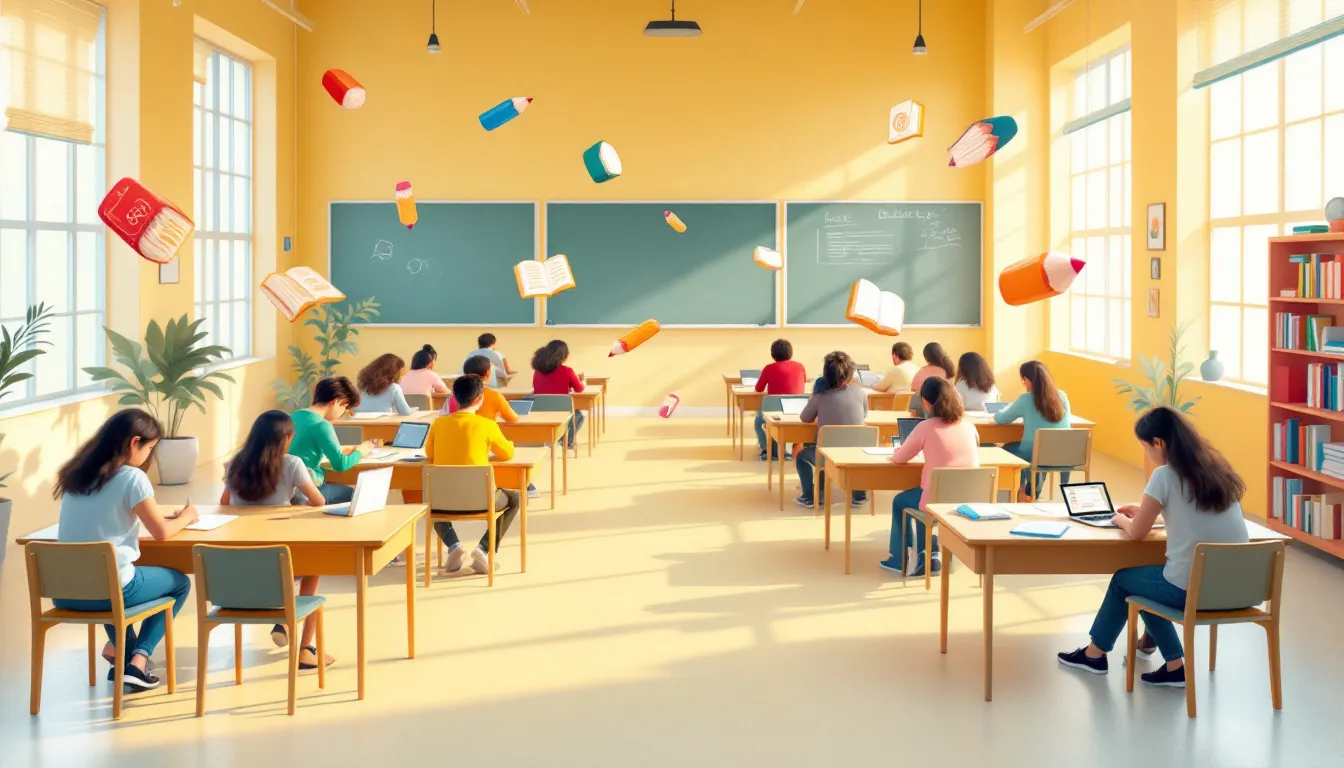Want better student performance? Your classroom setup matters more than you think. Here's what works in 2024:
| Key Area | Impact |
|---|---|
| Smart Layout | Boosts grades by 16% |
| Good Air & Light | Higher test scores, better focus |
| Flexible Seating | 78% of teachers see improved results |
| Tech Integration | 74% better student attention |
4 Must-Have Elements for Modern Classrooms:
- Physical Space: Mobile furniture + smart storage solutions
- Digital Tools: TeacherKit, ClassDojo, Google Classroom
- Hybrid Setup: In-person + online learning zones
- Student Zones: Group work, quiet study, discussion areas
Quick Setup Guide:
- Use movable tables and chairs
- Create dedicated zones for different activities
- Add digital tools that cut paper clutter
- Let students pick their workspaces
- Keep supplies at kid-height
- Label everything clearly
The proof? Schools using these setups see up to 25% better student performance. And when classrooms got better, 70% of students felt more motivated to show up.
Let's break down exactly how to organize your classroom for maximum learning success.
Physical Space Setup That Works
Let's talk about how to set up your classroom in a way that actually helps students learn better.
Smart Desk Arrangements Summit Prep High School figured out something cool: put wheels on your tables and chairs. Students can switch from solo work to group projects in seconds. Their smart move? Trapezoidal tables that fit together like puzzle pieces.
Keep It Clean, Keep It Simple Here's what works:
- Mount bike bottle holders on chairs (keeps water off desks)
- Use shoe organizers for headphones (no more tangled cords)
- Hang wire lines with clips across windows to show off student work
Quick Assignment Drop-Offs Set up these bins to make homework collection a breeze:
| Assignment Type | What Goes In |
|---|---|
| Daily Homework | Regular assignments |
| Big Projects | Multi-week work |
| Urgent Tasks | Need-it-now stuff |
"No matter what the physical space might be, it's the students making decisions to learn that marks a culture of learning." - Chris Kelly, History Teacher
Here's something interesting: The University of Salford found that classroom setup affects 16% of student grades. Mix these space tricks with smart seating, and you'll see students zero in on their work better.
2. Digital Organization Tools
Here are 3 digital tools that make classroom management easier:
TeacherKit ($3.99/month) Take attendance, track grades, and monitor behavior - all from your phone. No more paper records or messy spreadsheets. Just tap and go.
ClassDojo (Free) Share updates with parents in seconds. Post class photos, give behavior points, and send quick messages. Parents see everything in their feed, just like social media.
Google Drive + Classroom Store your teaching stuff in the cloud and access it anywhere. Here's what you can do:
| Task | How It Works |
|---|---|
| Collect Work | Students turn in assignments through Google Docs |
| Grade Fast | Add comments right on student work |
| Stay Organized | Sort everything into subject folders |
| Share Materials | Send files to students with one click |
"Google Classroom makes it simple to manage assignments, grades and feedback across Drive, Docs, Slides and Sheets." - Google Education Team
These tools work together to cut the paper clutter. And since they're free or low-cost, they fit any budget. The best part? Everything stays in one spot - no more hunting through stacks of papers or multiple apps.
3. Hybrid Learning Design
Here are 3 ways to set up your classroom for both in-person and online students:
1. Station Rotation Setup
Your classroom needs 3 zones: a teaching area, online workstations, and hands-on activity spaces. Students stay put while switching between tasks. Add webcams and mics at each spot so online students can jump right in.
| Area | In-Person Setup | Online Setup |
|---|---|---|
| Teaching Space | Movement-tracking camera | Recorded lessons |
| Student Areas | Sound panels | Online group rooms |
| Group Space | Multiple microphones | Digital forums |
3. Self-Paced Centers
Set up individual spots with headphones and charging stations. A 2022 study shows 82% of students want some online learning time - this setup lets them work how they want.
"Teaching a concurrent classroom is a daunting task. I am hopeful that strategies and best practices for K-12 will blossom out of this challenging school year as teachers experiment, reflect, create, and share." - Dr. Catlin Tucker, Author and Educator
For students at home, get them good headsets to cut out background noise. Put your camera on a tracking mount so you can move around while teaching - this keeps both in-person AND online students focused on the lesson.
sbb-itb-bb2be89
4. Student-Centered Spaces
Let's talk about classroom seating that actually works.
Think beyond rows of desks. Your classroom can have different zones that match how students learn best. Here's what works:
| Zone | What It's For | How to Set It Up |
|---|---|---|
| Campfire | Group work and discussions | Round tables + comfy chairs with wheels |
| Cave | Solo focus time | Quiet corners with bean bags + noise-canceling headphones |
| Watering Hole | Quick chats and brainstorming | Standing-height tables for 2-3 people |
This isn't just theory - it works in real classrooms. Take Tina Marchiano's English class at Pascack Valley High School. She ditched standard desks for these zones. Now her students pick spots based on what they're doing.
"Kids come in and feel a sense of comfort and belonging in there." - Tina Marchiano, English Teacher at Pascack Valley High School
The district's superintendent backs this up:
"It's important for students, when they are spending hours in school, to be not just sitting behind a laptop, not just sitting in rows of desks, but getting up, moving, to increase engagement." - Erik Gundersen, Superintendent of Pascack Valley District
Want to try this in your classroom? Here's what to do:
- Add one new seating option at a time
- Give students freedom to move between spots
- Keep groups small (4-5 students max)
- Make sure students can move easily between areas
Conclusion
Here's what makes classrooms work in 2024:
| Element | Impact on Learning | Real Results |
|---|---|---|
| Moving Furniture | Students choose spots for different tasks | 78% of teachers see better results |
| Easy Tech Access | Students grab tools when needed | 74% of students pay more attention |
| Student Input | Kids pick their workspaces | 30% more students like their classroom |
Let me show you what this looks like in action:
École Champs Vallée School switched to tables and chairs they can move around. Their students now jump between solo work and team projects in seconds. K-12 Huntsville School added chairs that rock and stools that wobble - their kids focus better.
"When tech fits naturally in the classroom, it does two things: gets students ready for today's digital world AND makes learning more fun." - Karen Cator, Digital Promise
What's working NOW:
- Mix old-school and digital tools
- Pick furniture you can move
- Create quiet corners
- Put tech where it's easy to reach
- Let kids choose their spots
Here's the bottom line: Your classroom should fit your students like a glove. When kids feel at home in their space, they learn better.
"When students can control their learning space, they learn to work on their own and handle change better." - Dr. Jane McGonigal
One last thing: Your classroom's not stuck in place. See what helps your students. Fix what doesn't. Your students will point you in the right direction.
FAQs
How can you organize your classroom strategically?
Here's a no-nonsense guide to classroom organization that works:
| Strategy | How to Do It | Impact |
|---|---|---|
| Daily Checklists | List tasks, materials, cleanup steps | Kids know their responsibilities |
| Color Coding | Match colors to subjects and spaces | Fast item finding and cleanup |
| Storage Bins | Clear containers with big labels | Easy access to materials |
| Digital Tools | Online planners and apps | Less physical clutter |
Here's what a real teacher does:
"I put clear labels on every bin. My students grab what they need and know exactly where things go back. It makes them more independent." - Catherine, The Brown Bag Teacher
Make it work in 4 steps:
- Keep supplies at kid-height: Students can get and return items without help
- Label everything: From pencil bins to activity zones
- Front-load daily items: Keep frequently used stuff within arm's reach
- Use clear containers: Everyone sees what's inside
Pro tip: Get a 10-drawer rolling cart. Label 5 drawers for each day of the week. Use the other 5 for copies, extra supplies, and reading materials.
Keep it running smooth:
- Assign classroom jobs
- Set a 5-minute cleanup timer
- Fix one problem area each week
- Put supplies where you use them


